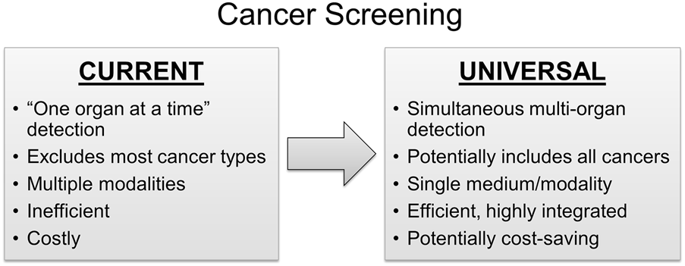npj Precision Oncology ( IF 7.9 ) Pub Date : 2018-10-29 , DOI: 10.1038/s41698-018-0066-x David A. Ahlquist

|
Cancer remains the second leading cause of mortality worldwide, and overall cancer-related deaths are increasing. Despite the survival benefit from early detection, screening has to date targeted only those few organs that harbor tumors of sufficient prevalence to show cost-effectiveness at population levels, leaving most cancer types unscreened. In this perspective overview, a case is made for universal cancer screening as a logical and more inclusive approach with potentially high impact. The centrally important conceptual drivers to universal screening are biological and epidemiological. The shared biology of tumor marker release into a common distant medium, like blood, can be exploited for multi-cancer detection from a single test. And, by aggregating prevalence rates, universal screening allows all cancers (including less common ones) to be included as targets, increases screening efficiency and integration across tumor types, and potentially improves cost-effectiveness over single-organ approaches. The identification of new tumor marker classes with both broad expression across tumor types and site-prediction, remarkable advances in assay technologies, and compelling early clinical data increase the likelihood of actualizing this new paradigm. Multi-organ screening could be achieved by targeting markers within or stemming from the circulation (including blood, urine, saliva, and expired breath) or those exfoliated into common excretory pathways (including the gastrointestinal and female reproductive tracts). Rigorous clinical studies in intended use populations and collaborations between academia, industry, professional societies, and government will be required to bring this lofty vision to a population application.
中文翻译:

通用癌症筛查:革命性,合理性和可实现性
癌症仍然是全球范围内第二大死亡原因,与癌症相关的总死亡人数正在增加。尽管早期检测可带来生存优势,但迄今为止,筛查仅针对那些具有足够流行率的肿瘤的少数器官,以在人群水平上显示出成本效益,而大多数癌症类型仍未经筛查。在此观点的概述中,有理由将普遍的癌症筛查作为一种具有逻辑性和更具包容性的方法,具有潜在的巨大影响。普遍筛查的最重要的概念驱动因素是生物学和流行病学。可以将肿瘤标志物释放到血液等共同远距离介质中的共享生物学功能用于一次检测中的多癌检测。而且,通过汇总患病率,通用筛查可以将所有癌症(包括较不常见的癌症)作为靶标,提高筛查效率和跨肿瘤类型的整合,并可能提高单器官方法的成本效益。新的肿瘤标志物类别的识别具有跨肿瘤类型的广泛表达和定点预测,测定技术的显着进步以及令人信服的早期临床数据,增加了实现这种新范式的可能性。多器官筛查可以通过靶向循环内或源自循环(包括血液,尿液,唾液和呼出气)或脱落到常见排泄途径(包括胃肠道和女性生殖道)的标志物来实现。针对预期用途人群的严格临床研究以及学术界,行业,


























 京公网安备 11010802027423号
京公网安备 11010802027423号